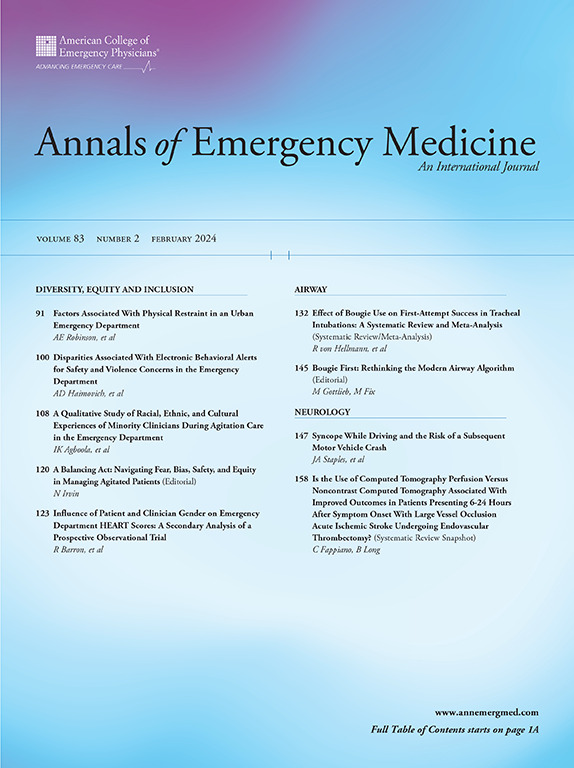Risk Factors for Traumatic Intracranial Hemorrhage in Older Adults Sustaining a Head Injury in Ground-Level Falls: A Systematic Review and Meta-analysis.
IF 5
1区 医学
Q1 EMERGENCY MEDICINE
引用次数: 0
Abstract
STUDY OBJECTIVE Ground-level falls have become the leading cause of head injury in older adults. However, the risk factors for traumatic intracranial hemorrhage (ICH) in this population remain unclear. We aimed to identify risk factors for traumatic ICH in older patients who sustained a ground-level fall-related head injury presenting in the emergency department. METHODS A systematic search of Medline (Ovid), Embase (Embase.com), Cochrane Library (Wiley), CINAHL (EBSCO), and Web of Science Core Collection was performed on December 9, 2024. The studies' eligibility criteria included patients aged 65 years and over who consulted in an emergency department following a ground-level fall-related head trauma and who presented with a Glasgow Coma Scale score of at least 13. Head injury was defined as any trauma to the head, including the face. Odds ratios (ORs) for each risk factor were pooled from the selected studies. For each potential risk factor, a random-effects model was used to compare the risk of traumatic ICH between patients with and without the risk factor. We restricted sensitivity analyses to studies providing adjusted odds ratios (AORs) and high-quality studies according to the Newcastle-Ottawa quality assessment Scale (defined as Newcastle-Ottawa quality assessment Scale score ≥7). RESULTS A total of 17 observational studies involving 22,520 patients were included in this systematic review with meta-analysis. Seven were prospective (11,501 individuals), and 8 were multicenter studies (14,376 individuals). The prevalence of traumatic ICH was 6.8% (95% confidence interval [CI]: 6.5 to 7.2), occurring in 1,538 patients. Among patients with traumatic ICH, urgent neurosurgery intervention prevalence was 8.0% (95% CI: 5.0 to 12.0). The unadjusted ORs indicate that the risk factors of traumatic ICH were suspected open or depressed skull fracture (OR: 10.9 [95% CI 6.4 to 18.7]), signs of basal skull fracture (OR: 4.7 [95% CI 3.4 to 6.5]), reduced baseline Glasgow Coma Scale score (OR: 4.0 [95% CI 3.4 to 4.7]), focal neurologic signs (OR: 3.8 [95% CI 3.2 to 4.5]), seizure (OR: 3.2, [95% CI 1.5 to 7.0]), vomiting (OR: 2.7 [95% CI 2.1 to 3.5]), amnesia (OR: 2.4 [95% CI 2.0 to 3.0]), loss of consciousness (OR: 2.3 [95% CI 1.9 to 2.8]), headache (OR: 2.1 [95% CI 1.6 to 2.9]), external sign of head trauma (OR: 2.0 [95% CI 1.7 to 2.3]), male sex (OR: 1.5 [95% CI 1.3 to 1.6]), chronic kidney disease (OR: 1.4 [95% CI 1.0 to 1.9]), preinjury single antiplatelet (OR: 1.2 [95% CI 1.0 to 1.3]), and dual antiplatelet medication (OR: 2.3 [95% CI 1.5 to 3.5]). Preinjury anticoagulant was not a significant risk factor (OR: 0.8 [95% CI 0.7 to 1.0]). Based on AOR, only focal neurologic signs (AOR: 4.4 [95% CI 3.0 to 6.5]), external sign of head trauma (AOR: 2.7 [95% CI 2.1 to 3.5]), loss of consciousness (AOR: 1.6 [95% CI 1.2 to 2.1]), and male sex (AOR: 1.4 [95% CI 1.2 to 1.6]) remained associated with traumatic ICH. CONCLUSIONS This study identified risk factors for traumatic ICH that can be recognized in older patients presenting in the emergency department for a ground-level fall-related head injury. Based on these findings, there is a need for future prospective studies to evaluate potentially avoidable head computed tomography scans in this population.老年人在地面坠落中头部损伤的外伤性颅内出血的危险因素:系统回顾和荟萃分析。
研究目的:地面坠落已成为老年人头部损伤的主要原因。然而,该人群外伤性颅内出血(ICH)的危险因素仍不清楚。我们的目的是确定在急诊科就诊的因地面坠落而头部受伤的老年患者外伤性脑出血的危险因素。方法于2024年12月9日对Medline (Ovid)、Embase (Embase.com)、Cochrane Library (Wiley)、CINAHL (EBSCO)、Web of Science Core Collection进行系统检索。研究的资格标准包括65岁及以上的患者,他们在地面跌倒相关的头部创伤后就诊于急诊科,并且格拉斯哥昏迷量表评分至少为13分。头部损伤的定义是任何头部外伤,包括脸部。从选定的研究中汇总每个危险因素的比值比(ORs)。对于每个潜在的危险因素,采用随机效应模型比较有和没有危险因素的患者的外伤性脑出血风险。我们将敏感性分析限制在根据纽卡斯尔-渥太华质量评估量表(定义为纽卡斯尔-渥太华质量评估量表得分≥7)提供调整优势比(AORs)的研究和高质量研究。结果本系统综述纳入了17项观察性研究,涉及22,520例患者。7项是前瞻性研究(11,501人),8项是多中心研究(14,376人)。外伤性脑出血患病率为6.8%(95%可信区间[CI]: 6.5 - 7.2),共1538例患者。在外伤性脑出血患者中,紧急神经外科干预患病率为8.0% (95% CI: 5.0 ~ 12.0)。未经调整的口服补液盐的风险因素表明,创伤我被怀疑打开或头骨碎裂(or: 10.9(95%可信区间6.4到18.7)),基底颅骨骨折的迹象(or: 4.7(95%可信区间3.4到6.5)),减少基线格拉斯哥昏迷评分分数(or: 4.0(95%可信区间3.4到4.7)),焦神经迹象(or: 3.8(95%可信区间3.2到4.5)),癫痫(or: 3.2,[95%可信区间1.5到7.0]),呕吐(or: 2.7(95%可信区间2.1到3.5)),失忆(or: 2.4(95%可信区间2.0到3.0)),意识丧失(或:2.3 [95% CI 1.9至2.8])、头痛(OR: 2.1 [95% CI 1.6至2.9])、头部外伤的外部征像(OR: 2.0 [95% CI 1.7至2.3])、男性(OR: 1.5 [95% CI 1.3至1.6])、慢性肾脏疾病(OR: 1.4 [95% CI 1.0至1.9])、损伤前单一抗血小板药物(OR: 1.2 [95% CI 1.0至1.3])和双重抗血小板药物(OR: 2.3 [95% CI 1.5至3.5])。损伤前抗凝剂不是显著的危险因素(OR: 0.8 [95% CI 0.7 ~ 1.0])。基于AOR,只有局灶性神经体征(AOR: 4.4 [95% CI 3.0至6.5])、头部外伤的外部体征(AOR: 2.7 [95% CI 2.1至3.5])、意识丧失(AOR: 1.6 [95% CI 1.2至2.1])和男性(AOR: 1.4 [95% CI 1.2至1.6])与外伤性脑出血有关。结论:本研究确定了外伤性脑出血的危险因素,这些因素可以在急诊科因地面坠落相关头部损伤就诊的老年患者中被识别出来。基于这些发现,未来有必要进行前瞻性研究,以评估在这一人群中可能可避免的头部计算机断层扫描。
本文章由计算机程序翻译,如有差异,请以英文原文为准。
求助全文
约1分钟内获得全文
求助全文
来源期刊

Annals of emergency medicine
医学-急救医学
CiteScore
8.30
自引率
4.80%
发文量
819
审稿时长
20 days
期刊介绍:
Annals of Emergency Medicine, the official journal of the American College of Emergency Physicians, is an international, peer-reviewed journal dedicated to improving the quality of care by publishing the highest quality science for emergency medicine and related medical specialties. Annals publishes original research, clinical reports, opinion, and educational information related to the practice, teaching, and research of emergency medicine. In addition to general emergency medicine topics, Annals regularly publishes articles on out-of-hospital emergency medical services, pediatric emergency medicine, injury and disease prevention, health policy and ethics, disaster management, toxicology, and related topics.
 求助内容:
求助内容: 应助结果提醒方式:
应助结果提醒方式:


